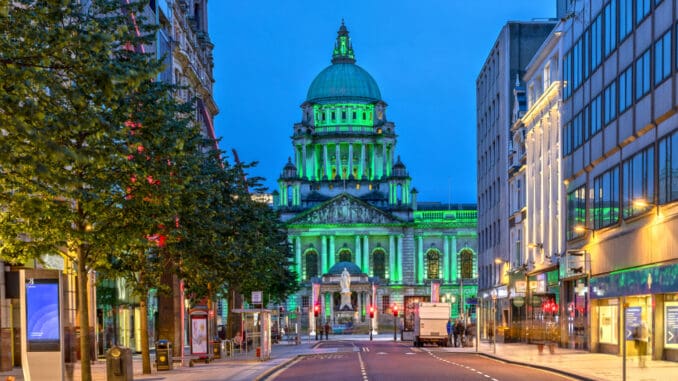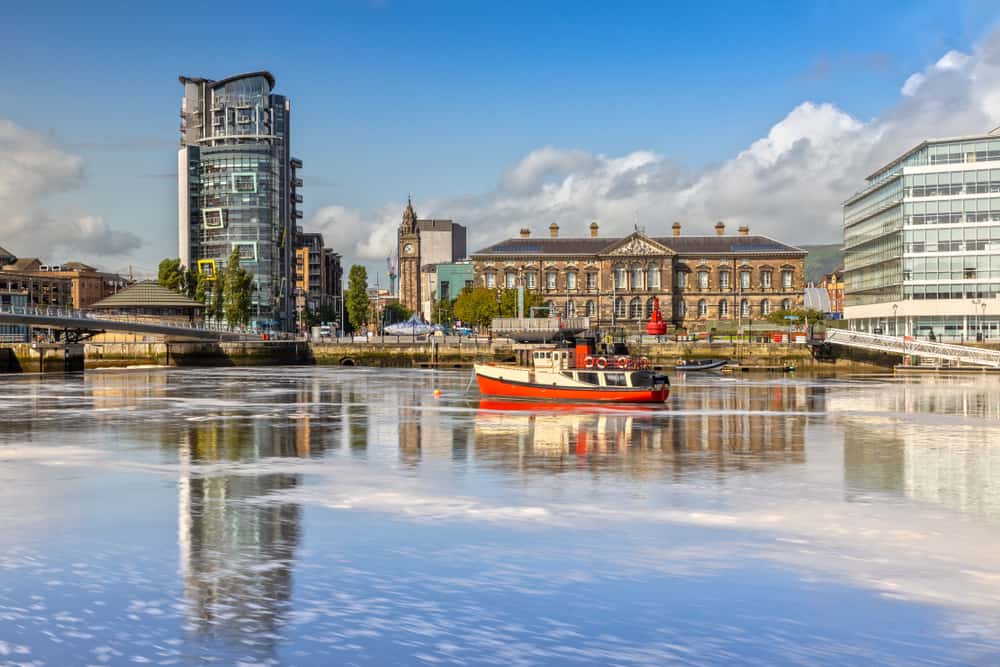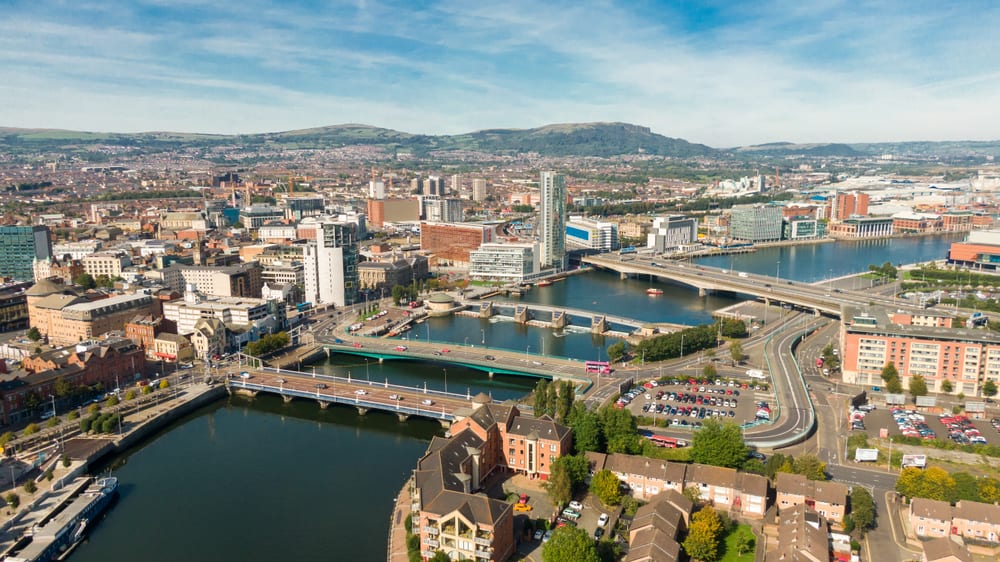
The capital of Northern Ireland is Belfast – which, in Gaelic, translates to ‘mouth of the sandbank ford.’ The name is an accurate one, given Belfast’s location on the banks of the River Lagan.
Belfast is the second largest city in Ireland and the twelfth largest city in the United Kingdom, as Northern Ireland is a small region measuring 5,456 square miles with a population of 1.7 million. Belfast is home to about one-fifth of Northern Ireland’s citizens, the city’s population being 345,418 as of 2021.
Learn more about this interesting city in this lesser-known province of the United Kingdom.
Where is the Capital of Northern Ireland Located?

Belfast is located at the headwaters of the River Lagan and sits at the western and narrowest end of the Belfast Lough, which empties into the North Channel.
Surrounding Belfast is a lush green temperate climate that applies to most of the Emerald Isle. Belfast is located between two major bodies of water: Lough Neagh (landlocked near central Northern Ireland) and Stranford Lough, which empties into the Irish Sea via a short, narrow channel.
While there are no mountains near the city – or any in Ireland at all – Belfast sits near three sizable hills: Divis Mountain, Black Mountain, and Cave Hill.
Brief History of Belfast

Belfast was first founded as a quiet settlement largely ignored during the Middle Ages before becoming more populated and industrious in the 1800s onward.
Early Days
Archeologists have discovered that people have lived in the Belfast area since the Bronze and Iron Ages, and one such archeological wonder still standing today is the Giant’s Ring – a circular henge dating back roughly 5,000 years and built by the early Neolithic people of the region.
In 1616, Belfast was officially named a town by Sir Arthur Chichester during Plantation – a period of tension and strife during Irish history when lands owned by the Irish were seized by the English crown in an attempt to civilize the Gaelic, whom the English believed uncivilized and in need of English influence.
It is believed that the French and Scottish settlers who’d come to Belfast during Plantation were responsible for introducing linen – a material that soon became a vital source of Belfast’s economy.
Pre- and Post- War Belfast
Belfast fared well during the Industrial Revolution, as the city was a major producer of linen – earning the city the nickname “Linenopolis.”
But linen isn’t all Belfast is known for. Because of its prominence as a shipbuilding hub, Belfast is most famous for the Harland ; Wolff shipyard, where the infamous RMS Titanic – which notoriously struck an iceberg and sank while moving through frigid waters in 1912 – was built.
At the time, Harland Wolff was the world’s largest shipyard, and was responsible for building most of the world’s ocean liners as well as the ships for the UK’s Royal Navy.
Modern Day Belfast
Tensions in Northern Ireland between the UK and the country of Ireland negatively affected Belfast’s growth and economic success. The city was the frequent site of violent attacks between nationalists and unionists, including those from the notorious Irish Republican Army (IRA) and the Loyalists.
This series of domestic terrorist attacks became known as The Troubles – a period of time between the 1960s to 1998, ending with the signing of the Good Friday Agreement.
Finally, after decades of violence, a tentative peace emerged between the IRA and the loyalists with the 1998 signing of the Good Friday Agreement (also known as the Belfast Treaty) that ended much of the violence between the two parties.
The signing of this treaty helped Belfast regain much of its economic growth and prominence as a trade and shipbuilding hub.
When did Belfast Become the Capital of Northern Ireland?

While the city itself was founded in 1616 by Sir Arthur Chichester during Plantation, Belfast didn’t become Northern Ireland’s capital until 1921, when the partition of Ireland divided up the republic of Ireland and the provinces of the United Kingdom, including Northern Ireland.
Today, Belfast is the seat of government for Northern Ireland.
Why is Belfast the Capital of Northern Ireland?
Belfast became the seat of Northern Ireland’s government during partition, when the United Kingdom separated Northern Ireland from the republic of Ireland.
Belfast’s prime location at the mouth of River Lagan and at the narrow end of the Belfast Lough contributed to its prominence as a shipbuilding hub, which fueled a large part of its economy during the industrial revolution and helped it grow to the largest city in Northern Ireland.
Belfast’s size helped it become the center of industry, making it the most logical choice for the province’s capital city.
Best Places to Visit in Belfast
Whether you’re visiting Belfast on business with some time to kill or are planning a once-in-a-lifetime trip to the Emerald Isle, you’ll never be bored in this wonderful city.
Below are just some of the exciting places to visit for both locals and tourists alike.
- Titanic Belfast – this aluminum-clad museum memorializes the tragic sinking of the RMS Titanic, which was built in Belfast’s very own Harland ; Wolff shipyard. Learn all about the Titanic and its haunting legacy in its nine galleries and special effects.
- Ulster Museum – this museum features a rich collection of natural history, science, and art.
- CS Lewis Square – travel through Narnia in this open space dedicated to the legacy of Belfast-born author CS Lewis. The space features seven bronze sculptures of fabled characters from Lewis’s The Chronicles of Narnia.
- Belfast Castle – built in the 1860s, Belfast Castle is located in the northern part of Belfast near Cave Hill.
- Cave Hill Visitor’s Center – for adventurous travelers, there’s nothing quite like Cave Hill. This Northern Irish landmark has a wealth of archeological sites, wildlife species, and includes Cave Hill Adventure Playground for the little ones.
Belfast City Hall – this iconic building was built in 1906 and teaches visitors all about the history of Northern Ireland’s capital city. At night, multi-colored lights illuminate the building and make the historic landmark an eye-catching display.
